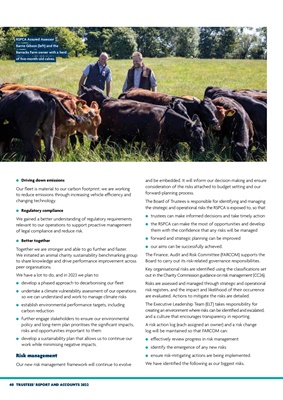
TRUSTEES' REPORT AND ACCOUNTS 2022
40 l Driving down emissions
Our fleet is material to our carbon footprint; we are working
to reduce emissions through increasing vehicle efficiency and
changing technology.
l Regulatory compliance
We gained a better understanding of regulatory requirements
relevant to our operations to support proactive management
of legal compliance and reduce risk.
l Better together
Together we are stronger and able to go further and faster.
We initiated an animal charity sustainability benchmarking group
to share knowledge and drive performance improvement across
peer organisations.
We have a lot to do, and in 2023 we plan to:
l develop a phased approach to decarbonising our fleet
l undertake a climate vulnerability assessment of our operations
so we can understand and work to manage climate risks
l establish environmental performance targets, including
carbon reduction
l further engage stakeholders to ensure our environmental
policy and long-term plan prioritises the significant impacts,
risks and opportunities important to them
l develop a sustainability plan that allows us to continue our
work while minimising negative impacts.
Risk management
Our new risk management framework will continue to evolve
and be embedded. It will inform our decision making and ensure
consideration of the risks attached to budget setting and our
forward-planning process.
The Board of Trustees is responsible for identifying and managing
the strategic and operational risks the RSPCA is exposed to, so that:
l trustees can make informed decisions and take timely action
l the RSPCA can make the most of opportunities and develop
them with the confidence that any risks will be managed
l forward and strategic planning can be improved
l our aims can be successfully achieved.
The Finance, Audit and Risk Committee (FARCOM) supports the
Board to carry out its risk-related governance responsibilities.
Key organisational risks are identified using the classifications set
out in the Charity Commission guidance on risk management (CC26).
Risks are assessed and managed through strategic and operational
risk registers, and the impact and likelihood of their occurrence
are evaluated. Actions to mitigate the risks are detailed.
The Executive Leadership Team (ELT) takes responsibility for
creating an environment where risks can be identified and escalated,
and a culture that encourages transparency in reporting.
A risk action log (each assigned an owner) and a risk change
log will be maintained so that FARCOM can:
l effectively review progress in risk management
l identify the emergence of any new risks
l ensure risk-mitigating actions are being implemented.
We have identified the following as our biggest risks.
RSPCA Assured Assessor
Barrie Gibson (left) and the
Barracks Farm owner with a herd
of five-month-old calves.